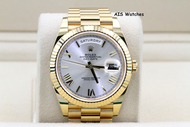The Evolution of Luxury Watch Materials: From Gold to Space-Age Alloys
Posted by AIS Watches on Mar 21st 2023
Luxury watches are a symbol of prestige and refinement, and have been sought after by collectors and enthusiasts for centuries. Throughout their long history, watchmakers have used a variety of materials to create timepieces that are not only beautiful but also functional and durable. From traditional materials like gold and silver to cutting-edge alloys developed by NASA, the evolution of luxury watch materials has been fascinating to witness. In this article, we will explore the history and evolution of luxury watch materials and the impact they have had on the industry.
Gold: The Classic Luxury Material
For centuries, gold has been the go-to material for luxury watches. Its timeless beauty, rarity, and durability have made it a favorite among watchmakers and collectors alike. The first gold watch was made in the 16th century, and since then, gold has been used to create some of the most iconic watches in history, such as the Rolex Day-Date and the Patek Philippe Calatrava.
https://aiswatches.com/rolex-228238-daydate-40mm-dd40-yellow-gold-silver-roman-dial-box-papers/
Silver: The Practical Luxury Material
While gold was the material of choice for luxury watches, silver was often used for more practical purposes. Silver is a soft and malleable metal that is easy to work with, making it ideal for creating complex watch designs. It was also less expensive than gold, which made it more accessible to a wider audience.
https://aiswatches.com/bnib-tudor-79010sg-black-bay-fifty-eight-58-silver-leather-strap-39mm/
Stainless Steel: The Game Changer
In the early 20th century, a new material emerged that would change the luxury watch industry forever: stainless steel. Stainless steel is a highly durable and corrosion-resistant alloy that was originally developed for use in cutlery and surgical instruments. However, watchmakers soon realized that stainless steel was an excellent material for watches as well. The first watch to use stainless steel was the Rolex Oyster, which was introduced in 1926. Since then, stainless steel has become the material of choice for many luxury watches, such as the Rolex Submariner and the Omega Speedmaster.
https://aiswatches.com/bnib-rolex-datejust-41mm-126334-silver-stick-dial-oyster-box-papers/
Titanium: The Lightweight Luxury Material
In the 1970s, another new material entered the luxury watch industry: titanium. Titanium is a lightweight and strong metal that is commonly used in aerospace and military applications. It is also hypoallergenic and corrosion-resistant, making it an ideal material for watches. The first titanium watch was the Citizen X-8 Chronometer, which was released in 1975. Since then, titanium has become a popular material for luxury watches, particularly in sports and diving watches.
https://aiswatches.com/bnib-tudor-pelagos-25600tb-blue-dial-titanium-box-paper-in-house-movement/
Ceramic: The High-Tech Luxury Material
In recent years, watchmakers have begun to experiment with new materials, such as ceramic. Ceramic is a high-tech material that is extremely scratch-resistant and can be produced in a variety of colors. Ceramic watches are particularly popular in the sports watch market, where their durability and functionality are highly valued. Examples of luxury ceramic watches include the Chanel J12 and the Omega Speedmaster Dark Side of the Moon.
https://aiswatches.com/panerai-pam-335-luminor-gmt-am-pm-dial-1950-10days-ceramic-44mm-box-paper/
Conclusion
The evolution of luxury watch materials has been a fascinating journey, from the classic beauty of gold to the cutting-edge technology of space-age alloys. Each material has its own unique qualities and has contributed to the development of some of the most iconic watches in history. As watchmakers continue to experiment with new materials, it will be exciting to see what the future holds for luxury watches.
 Menu
Menu




